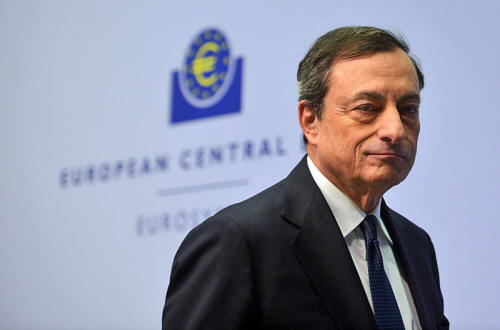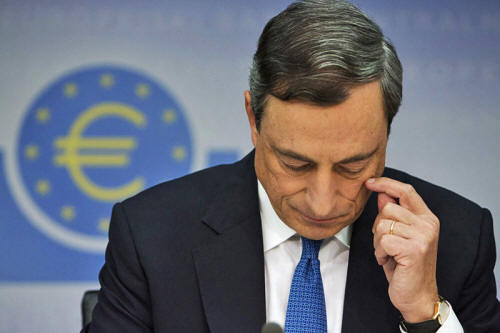Press Conference - ECB President
Mario Draghi
Introductory statement - 22 January 2015
Frankfurt am Main
from
ECB.Europa Website
Ladies and gentlemen, the Vice-President and I are very pleased
to welcome you to our press conference.
Let me wish you all a Happy New
Year. I would also like to take this opportunity to welcome
Lithuania as the nineteenth country to adopt the Euro as its
currency.
Accordingly, Mr Vasiliauskas,
the Chairman of the Board of Lietuvos bankas, became a member of
the Governing Council on 1 January 2015. The accession of
Lithuania to the Euro area on 1 January 2015 triggered a system
under which NCB governors take turns holding voting rights on
the Governing Council.
The details on this rotation system
are available on the ECB's Website.
We will now report on the outcome of
today's meeting of the Governing Council, which was also
attended by the Commission Vice-President, Mr Dombrovskis.
Based on our regular economic and monetary analyses, we
conducted a thorough reassessment of the outlook for price
developments and of the monetary stimulus achieved.
As a result,
the Governing Council took the
following decisions:
- First, it decided to
launch an expanded asset purchase program, encompassing the
existing purchase programs for asset-backed securities and
covered bonds.
Under this expanded program, the
combined monthly purchases of public and private sector
securities will amount to €60 billion.
They are intended to be carried
out until end-September 2016 and will in any case be
conducted until we see a sustained adjustment in the path of
inflation which is consistent with our aim of achieving
inflation rates below, but close to, 2% over the medium
term.
In March 2015 the Eurosystem
will start to purchase Euro-denominated investment-grade
securities issued by Euro area governments and agencies and
European institutions in the secondary market. The purchases
of securities issued by Euro area governments and agencies
will be based on the Eurosystem NCBs' shares in the ECB's
capital key.
Some additional eligibility
criteria will be applied in the case of countries under an
EU/IMF adjustment program.
- Second, the Governing Council decided to change the
pricing of the six remaining targeted longer-term
refinancing operations (TLTROs).
Accordingly , the interest rate
applicable to future TLTRO operations will be equal to the
rate on the Eurosystem's main refinancing operations
prevailing at the time when each TLTRO is conducted, thereby
removing the 10 basis point spread over the MRO rate that
applied to the first two TLTROs.
- Third, in line with our forward guidance, we decided
to keep the key ECB interest rates unchanged.
As regards the additional asset
purchases, the Governing Council retains control over all the
design features of the program and the ECB will coordinate the
purchases, thereby safeguarding the singleness of the
Eurosystem's monetary policy.
The Eurosystem will make use of
decentralized implementation to mobilize its resources. With
regard to the sharing of hypothetical losses, the Governing
Council decided that purchases of securities of European
institutions (which will be 12% of the additional asset
purchases, and which will be purchased by NCBs) will be subject
to loss sharing.
The rest of the NCBs' additional
asset purchases will not be subject to loss sharing. The ECB
will hold 8% of the additional asset purchases. This implies
that 20% of the additional asset purchases will be subject to a
regime of risk sharing.
Separate press releases with more
detailed information on the expanded asset purchase program and
the pricing of the TLTROs will be published this afternoon at
3.30 p.m.
Today's monetary policy decision on additional asset purchases
was taken to counter two unfavorable developments.
- First, inflation
dynamics have continued to be weaker than expected. While
the sharp fall in oil prices over recent months remains the
dominant factor driving current headline inflation, the
potential for second-round effects on wage and price-setting
has increased and could adversely affect medium-term price
developments.
This assessment is underpinned
by a further fall in market-based measures of inflation
expectations over all horizons and the fact that most
indicators of actual or expected inflation stand at, or
close to, their historical lows.
At the same time, economic slack
in the Euro area remains sizeable and money and credit
developments continue to be subdued.
- Second, while the
monetary policy measures adopted between June and September
last year resulted in a material improvement in terms of
financial market prices, this was not the case for the
quantitative results.
As a consequence, the prevailing
degree of monetary accommodation was insufficient to
adequately address heightened risks of too prolonged a
period of low inflation.
Thus, today the adoption of
further balance sheet measures has become warranted to
achieve our price stability objective, given that the key
ECB interest rates have reached their lower bound.
Looking ahead, today's measures will
decisively underpin the firm anchoring of medium to long-term
inflation expectations.
The sizeable increase in our balance
sheet will further ease the monetary policy stance. In
particular, financing conditions for firms and households in the
Euro area will continue to improve.
Moreover, today's decisions will
support our forward guidance on the key ECB interest rates and
reinforce the fact that there are significant and increasing
differences in the monetary policy cycle between major advanced
economies.
Taken together, these factors should
strengthen demand, increase capacity utilization and support
money and credit growth, and thereby contribute to a return of
inflation rates towards 2%.
Let me now explain our assessment in greater detail, starting
with the economic analysis.
Real GDP in the Euro area rose by
0.2%, quarter on quarter, in the third quarter of 2014. The
latest data and survey evidence point to continued moderate
growth at the turn of the year.
Looking ahead, recent declines in
oil prices have strengthened the basis for the economic recovery
to gain momentum. Lower oil prices should support households'
real disposable income and corporate profitability.
Domestic demand should also be
further supported by our monetary policy measures, the ongoing
improvements in financial conditions and the progress made in
fiscal consolidation and structural reforms.
Furthermore, demand for exports
should benefit from the global recovery. However, the Euro area
recovery is likely to continue to be dampened by high
unemployment, sizeable unutilized capacity, and the necessary
balance sheet adjustments in the public and private sectors.
The risks surrounding the economic outlook for the Euro area
remain on the downside, but should have diminished after today's
monetary policy decisions and the continued fall in oil prices
over recent weeks.
According to Eurostat, Euro area annual HICP inflation was -0.2%
in December 2014, after 0.3% in November.
This decline mainly reflects a sharp
fall in energy price inflation and, to a lesser extent, a
decline in the annual rate of change in food prices. On the
basis of current information and prevailing futures prices for
oil, annual HICP inflation is expected to remain very low or
negative in the months ahead.
Such low inflation rates are
unavoidable in the short term, given the recent very sharp fall
in oil prices and assuming that no significant correction will
take place in the next few months.
Supported by our monetary policy
measures, the expected recovery in demand and the assumption of
a gradual increase in oil prices in the period ahead, inflation
rates are expected to increase gradually later in 2015 and in
2016.
The Governing Council will continue to closely monitor the risks
to the outlook for price developments over the medium term. In
this context, we will focus in particular on geopolitical
developments, exchange rate and energy price developments, and
the pass-through of our monetary policy measures.
Turning to the monetary analysis, recent data indicate a pick-up
in underlying growth in
broad money (M3),
although it remains at low levels. The annual growth rate of M3
increased to 3.1% in November 2014, up from 2.5% in October and
a trough of 0.8% in April 2014.
Annual growth in M3 continues to be
supported by its most liquid components, with the narrow
monetary aggregate M1 growing at an annual rate of 6.9% in
November.
The annual rate of change of loans to non-financial corporations
(adjusted for loan sales and securitization) remained weak at
-1.3% in November 2014, compared with -1.6% in October, while
continuing its gradual recovery from a trough of -3.2% in
February 2014.
On average over recent months, net
redemptions have moderated from the historically high levels
recorded a year ago and net lending flows turned slightly
positive in November.
In this respect, the January 2015
bank lending survey indicates a further net easing of credit
standards in the fourth quarter of 2014, with cross-country
disparities decreasing in parallel with an increase in net
demand for loans across all loan categories.
Banks expect that these dynamics
will continue in early 2015.
Despite these improvements, lending
to non-financial corporations remains weak and continues to
reflect the lagged relationship with the business cycle, credit
risk, credit supply factors and the ongoing adjustment of
financial and non-financial sector balance sheets.
The annual growth rate of loans to
households (adjusted for loan sales and securitization) was 0.7%
in November, after 0.6% in October. Our monetary policy measures
should support a further improvement in credit flows.
To sum up, a cross-check of the outcome of the economic analysis
with the signals coming from the monetary analysis confirmed the
need for further monetary policy accommodation. All our monetary
policy measures should provide support to the Euro area recovery
and bring inflation rates closer to levels below, but close to,
2%.
Monetary policy is focused on maintaining price stability over
the medium term and its accommodative stance contributes to
supporting economic activity. However, in order to increase
investment activity, boost job creation and raise productivity
growth, other policy areas need to contribute decisively.
In particular, the determined
implementation of product and labour market reforms as well as
actions to improve the business environment for firms needs to
gain momentum in several countries.
It is crucial that structural
reforms be implemented swiftly, credibly and effectively as this
will not only increase the future sustainable growth of the Euro
area, but will also raise expectations of higher incomes and
encourage firms to increase investment today and bring forward
the economic recovery.
Fiscal policies should support the
economic recovery, while ensuring debt sustainability in
compliance with the Stability and Growth Pact, which remains the
anchor for confidence.
All countries should use the
available scope for a more growth-friendly composition of fiscal
policies.
We are now at your disposal for questions.



